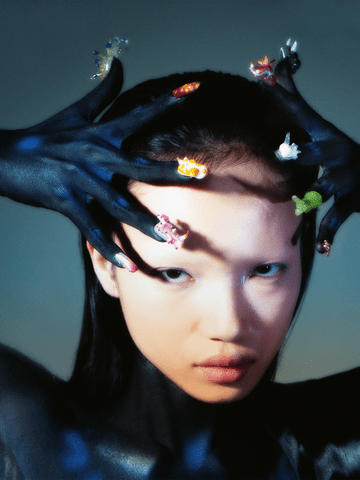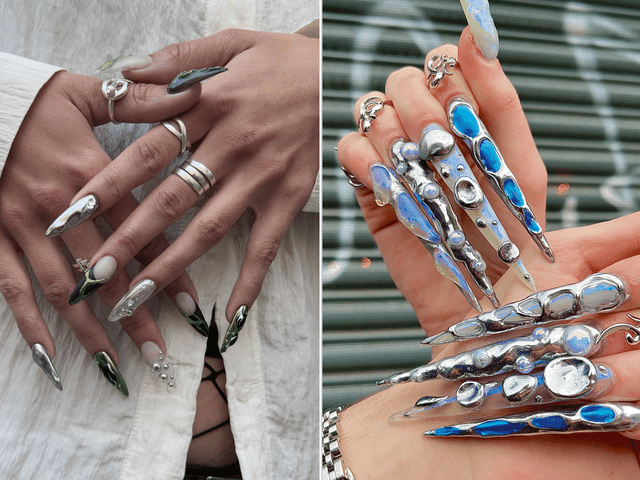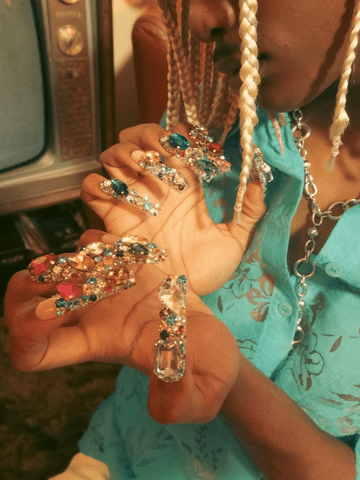The Rich History—and Complicated Present—of Nail Culture
Unpacking with 'Fresh Sets' author Tembe Denton-Hurst.

Nail art dates back centuries. However, the extravagant manicures widely seen today—think: metallic accents or abstract designs—were popularized in the '80s and '90s. Now, illustrated nails are more elaborate than ever, featuring everything from 3D embellishments to mismatched chrome , and continue to be embraced by the masses. Society's decades-long fascination with creative expression through nail art has sparked much discourse, from its history to the artists behind the manis to its future as a real art form. In her new book, Fresh Sets: Contemporary Nail Art From Around The World , journalist Tembe Denton-Hurst explores all of the above.
The book highlights some of the brilliant work of artists from New York, Vancouver, Paris, Seoul, Punjab, and other cities around the globe. Readers are taken on a journey of the nail techs' varying aesthetics, processes, and perspectives. The collection beautifully captures the rich technical and creative history of nail art. Ahead, Denton-Hurst talks to Single Sparkleabout her inspiration behind Fresh Sets , some of her favorite nail innovations, and the cultural significance of nail art.
Congrats on Fresh Sets ! Tell me how your work as a beauty journalist prepared you to write this book.
"One of the earlier stories I wrote for Them was about being a lesbian wearing acrylics , and what that meant to me. Nails have always been a part of the conversation. And when I wrote the story for The Cut in 2021 about respectability politics and how that showed up for me, even being in a creative industry, it was centered around nails and how I was always wearing more neutral and shorter sets because I didn't want to be perceived as loud and ghetto. I was trying to comport myself into a certain picture of legibility. So, nails have always been an interesting signifier for me and a way into a conversation, because I believe beauty and culture are intimately linked. When this opportunity came across my desk, I thought, Oh, this is perfect . It felt very synergistic."

The history of nails is so long, but can you talk specifically about the innovations in Japan in the early 2000s and the global impact on nail culture for this generation?
"Japan has made an invaluable contribution to the nail situation today, pushing more 3D, decorative nails. Even though there are different aesthetics, they are rooted in the same practices. Also, the advancements in gel nail technology coming out of Japan shifted how we thought about how nails could be done, how they looked, and the possibilities. If I had to think of something that has had the most influence on culture in the past five to 10 years, it's been Aprés [pre-shaped soft gel nails] just because artists no longer have to think about building the foundation of the nail. They can just move on to doing art and more complex designs. The time a service takes is cut in half in many circumstances because of Aprés, and I think that Aprés is building on the Japanese gel technology and that tradition."
What innovative nail trends stood out to you while talking to different nail artists for this book?
"One thing I was fascinated by was 3D printing, which some artists use to create nail sculptures. People were also sculpting with polymer and acrylic gels. I think we'll see more of that. Many artists are really using the nail to its fullest extent. We're seeing these increasingly impractical but very cool hyper-realistic sculptures on nails. Nature also inspires a lot of nail art. When I would ask the nail artists, 'What are your inspirations?', they'd be like, 'Oh, I love bringing nature to the nail.' So it could be the shape of a leaf or a frog."
For someone who thinks nails are purely cosmetic, what might they be surprised to know about the art?
"I don't think they understand that this is its own form of artistry. Nail art was never necessarily looked at as an art form. It was considered a beauty routine and had more to do with the wearer than the creator. We're starting to see nail artists make a name for themselves. I think people would be surprised to know that the process for nail artists is very similar to that of any other visual artist. They're drawing inspiration from everything—it could be a movie or nature. So, I'm excited to see the conversation shifting and making room for artistry outside of just people attending art school."

Do you think some of this popularization is also because the face of those who wear bold nails has expanded? Growing up, I remember extravagant nails were mainly seen on Black and brown people. But now everyone is wearing them.
"To your point, there is an appropriative element. The woman you know with the flyest nails used to be the bus driver or your bank teller—and she still has the flyest nails. The people who were wearing long nails or extravagant designs were most likely going to be somebody who was not considered a tastemaker. [Society] would have looked at that person as ghetto. But I think the effect of [appropriation] has been a normalization of it, which also shifted the price point. Before, you could go to your local nail salon and do some crazy long sets for $90. Now you have the 'luxury nail artist' who you're spending $400 to see."
"A lot of converging factors have shifted the environment of nail art. There is an element of rising tides lifting all boats, because we are now freer as a result. But I do think that there is something complicated and infuriating about there needing to be some element of white adoption for that to happen. The people who are doing the more complex nail art are [people of color]. Ten years ago, when we had Paintbox, that kind of nail art was led by white women. Backstage at Theory or Alexander Wang [during New York Fashion Week], [white women] were keying shows. People [of color] who've been committed to long and loud nails now have an opportunity and pathway for visibility that they genuinely did not have before, because fashion was not interested in that."

That's such a thoughtful answer. How has nail art fostered a sense of community for women and the queer community?
"From a client perspective, it's become a safe and communal space in that when you see somebody with long nails, you look at them like, O kay, I see you. That's cute . Another rising tides lift all boats kind of thing is that [straight] men are getting manicures more often now and experimenting with nail art. This is partly due to people like A$AP Rocky, who keep their nails done. That has been net positive, ultimately, in that men feel freer. We're having newer conversations around masculinity. Queer men have been at the forefront of that, but I do think it makes it safer for queer expression. That's something that's hard about appropriation. Wider adoption normalizes something, and so then it makes it safer for people to partake in things that feel deeply sentimental or cultural, and feel part of one's identity. So it's an interesting line. It's not that cultural appropriation is good at all, but by more people engaging in a certain practice, it then makes it safer for other people to do that out loud."
Read the original article on Single Sparkle
Post a Comment